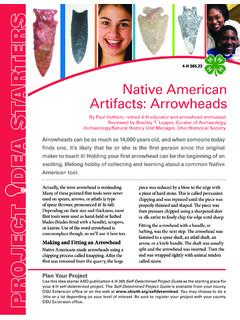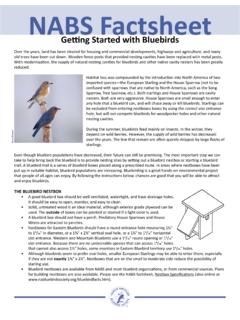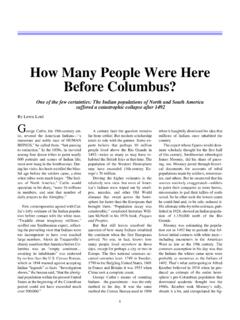Transcription of Native American Artifacts: Arrowheads
1 Actually, the term arrowhead is misleading. Many of these pointed flint tools were never used on spears, arrows, or atlatls (a type of spear thrower, pronounced t'-l -t l). Depending on their size and thickness, most flint tools were used as hand-held or hafted blades (blades fitted with a handle), scrapers, or knives. Use of the word arrowhead is commonplace though, so we ll use it here and Fitting an Arrowhead Native Americans made Arrowheads using a chipping process called knapping. After the flint was removed from the quarry, the large By Paul Hothem, retired 4-H educator and arrowhead enthusiastReviewed by Bradley T. Lepper, Curator of Archaeology, Archaeology/Natural History Unit Manager, Ohio Historical SocietyArrowheads can be as much as 14,000 years old, and when someone today finds one, it s likely that he or she is the first person since the original maker to touch it!
2 Holding your first arrowhead can be the beginning of an exciting, lifelong hobby of collecting and learning about a common Native American Your ProjectUse this idea starter AND publication 4-H 365 Self-Determined Project Guide as the starting place for your 4-H self-determined project. The Self-Determined Project Guide is available from your county OSU Extension office or on the web at You may choose to do a little or a lot depending on your level of interest. Be sure to register your project with your county OSU Extension was reduced by a blow to the edge with a piece of hard stone. This is called percussion chipping and was repeated until the piece was properly thinned and shaped.
3 The piece was then pressure chipped using a sharpened deer or elk antler to finely chip the edge until the arrowhead with a handle, or hafting, was the next step. The arrowhead was fastened to a spear shaft, an atlatl shaft, an arrow, or a knife handle. The shaft was usually split and the arrowhead was inserted. Then the end was wrapped tightly with animal tendon called American Artifacts: Arrowheads4-H HuntingWhere should you choose to search for Arrowheads on a farm? Put yourself in the shoes of a Native American living off the land and in need a reliable water source. Try to choose a field with a stream or flowing spring. Water was needed for survival and attracted animals to hunt.
4 You must obtain permission to hunt for Arrowheads on a farmer s land. Once it is given, visit the fields after they have been tilled and after at least half an inch of rain has fallen. The rain washes the dirt off the flint making it easier to you hunt for Arrowheads , you may find areas that have much more flint than elsewhere. This is called a worksite. You might not find many finished tools there, but the animal hunting areas would be nearby. Here is where most Arrowheads are t give up if you do not find anything on your first hunt. Continue to look after each new tilling and planting. Cornfields can be walked until the plants are knee high, as long as it is all right with the farmer.
5 Don t walk on soybean fields after you have found an arrowhead, take it home and wash it with cold water, dish soap, and an old toothbrush. Clean gently until the dirt is off. Don t scrub! Scrubbing removes the old patina and reduces its value. Patina is a film that appears gradually on some surfaces when exposed to oxygen. For safe-keeping, place your finds in an inexpensive tray with a glass other collectors, you may find it useful to keep a record, or catalog, of your items. Here is one way to list your finds:NumberTypeFinderLocationLength01 AdenaJ. DoeKnox Co., Ohio2 Include as much detail as possible when listing the location, such as, NE part of John Smith s field.
6 Adding latitude and longitude coordinates from a GPS device is is done with a fine-tip black marking pen on all pieces but dark flint. Use a pen with white ink on dark pieces. The number is all you need to put on the piece, but location is sometimes included. The photo below shows two examples. The piece on the left shows the county (Franklin) where it was found. The piece on the right shows the owner s code (HP) with the piece s number (865) and the location (Seneca Co.).Cultures and Time PeriodsThe lifestyles and tools of Native Americans evolved over 8,000 to 10,000 years. Archeological evidence tells us how they might have lived and what tools they needed for Paleoindian cultures 14,000 10,500 (Before Present)These people, who were of Asian descent, crossed the land bridge into the Alaska-Canada area of north America.
7 They moved in small family groups some-times following animal herds to obtain meat for food and hides for clothing. They are best known for their fluted points, which are fluted on one or both Paleoindian Plano culture 10,500 9,000 were the descendants of the early Paleoindians and lived a less nomadic lifestyle. Their Arrowheads changed slightly from the Paleoindian, most notably on the bases, which were no longer 9,000 4,500 cultures lived more settled lifestyles with bigger populations in villages and made many different types of Arrowheads . They were the first cultures to make stone tools such as axes, celts, adzes, and 3,000 1,400 This culture includes the Adena and Hopewell cultures and was the first to make pottery.
8 They are noted for their mounds, enclosures, and several other types of earthen works. Each group made mainly one type of arrowhead with very few variations. 3 Fort Ancient 1,000 500 people lived in large communities and raised crops like corn, pumpkins, and squash. They hunted animals with bows and arrows, so their Arrowheads were actually used as tips for arrows. All of their flint tools were triangle 0 0 Native peoples in the Ohio Valley were ravaged by European-introduced diseases. Iroquois tribes drove out survivors and claimed the region as their territory. 300 Many Native American groups moved in from other areas. Some flint was still used, but as the settlers moved in, the groups traded for guns and for Hunting GameSpearThe first weapon was the spear.
9 Early people probably found a straight sapling or limb; removed the bark, twigs, knots, etc.; then placed a spear point (large arrowhead) on the end. This weapon was thrown, usually when hunters were very close to their prey. This was very (spear thrower)The atlatl was a wooden handle about two feet long. At the back end a bone hook was attached. The wooden handle was used to throw darts (spears) with much more force than a spear used alone, which was in use prior to the atlatl by cultures outside north America. The first Americans arrived with atlatls. The dart (an oversized arrow) was five or six feet long with the back end hollowed out to fit the bone hook on the atlatl.
10 The dart was held with the thumb and first finger. The other fingers held the atlatl. At the end of the spear was a small insert with the arrowhead attached. This allowed the thrower to reload a new insert. The thrower s arm moved back and then forward. When the atlatl reached about the halfway point the arrow sprang off the hook and flew through the air. This weapon could be accurate up to 100 and ArrowYou are probably familiar with the working of this weapon. It was more accurate and could be used at longer distances. They were also easier to carry and use than other weapons. Best evidence suggests that bows and arrows were introduced during the Late Woodland period 1,400 years of these weapons were phased out as traders and settlers entered the New TypesThe five most commonly used flint types in Ohio are Flint Ridge, Coshocton, Nellie Chert, Zaleski, and Indiana Hornstone.





